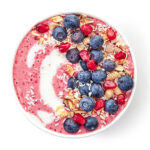Fruit Salad: A delightful medley of fresh, colorful fruits, carefully combined to create a refreshing and nutritious treat. With a burst of natural flavors and a visual feast of vibrant hues, fruit salads offer a simple yet delightful way to savor the goodness of nature’s bounty. Perfect for any occasion, this wholesome dish brings a touch of sweetness and healthiness to your plate.
Fruit Salad:
| Ingredients: | |
| 1 | Assorted fresh fruits (e.g., strawberries, blueberries, grapes, watermelon, cantaloupe, pineapple, kiwi, oranges, apples, bananas, etc.) |
| 2 | Fresh mint leaves (optional, for garnish) |
| 3 | For the Dressing (optional, but recommended for added flavor): |
| 4 | 2 tablespoons honey |
| 5 | 1 tablespoon freshly squeezed lemon juice |
| 6 | 1 teaspoon lime juice |
| 7 | A pinch of ground cinnamon (optional) |
Step-by-step cooking instruction of Fruit Salad:
Step-1 Wash and prepare the fruits: Start by washing all the fruits thoroughly under running water. Peel and chop the fruits as needed. For larger fruits like watermelon, cantaloupe, and pineapple, cut them into bite-sized chunks. For smaller fruits like berries, grapes, and kiwi, you can leave them whole or halve them.
Step-2 Toss the fruits: In a large mixing bowl, combine the assorted fruits gently. Be mindful not to crush or over mix the delicate fruits.
Step-3 Prepare the dressing (optional): In a separate small bowl, whisk together the honey, freshly squeezed lemon juice, lime juice, and ground cinnamon (if using) until well combined. The dressing adds a touch of sweetness and tanginess to enhance the flavors of the fruit salad.
Step-4 Dress the fruit salad (optional): Pour the dressing over the mixed fruits in the bowl. Gently toss the fruits with the dressing, ensuring each piece gets lightly coated. Adjust the amount of dressing to your taste preference, adding more if desired.
Step-5 Garnish and serve: If desired, tear some fresh mint leaves and sprinkle them over the fruit salad for an extra burst of freshness and aroma. Serve the fruit salad immediately for maximum flavor and texture.
Nutritional values of Fruit Salad:
The nutritional value of a fruit salad will depend on the specific fruits used and the quantity of each fruit in the salad. Generally, fruit salads are known for their high nutritional content, providing essential vitamins, minerals, and dietary fiber. Here’s an overview of the typical nutrients found in a fruit salad:
| 1 | Vitamins: Fruits are rich in various vitamins, including vitamin C (ascorbic acid), vitamin A (beta-carotene), vitamin K, vitamin E, and several B-vitamins. These vitamins play crucial roles in supporting immune function, maintaining healthy skin, promoting vision, and aiding in various metabolic processes. |
| 2 | Minerals: Fruit salads contribute to mineral intake, including potassium, magnesium, calcium, phosphorus, and trace minerals like iron and zinc. Potassium, in particular, is important for heart health and maintaining proper muscle function. |
| 3 | Dietary Fiber: Fruits are an excellent source of dietary fiber, which is essential for digestive health. Fiber aids in maintaining regular bowel movements, reducing cholesterol levels, and controlling blood sugar levels. |
| 4 | Antioxidants: Many fruits contain antioxidants, such as flavonoids, polyphenols, and carotenoids, which help protect the body from oxidative stress and inflammation. |
| 5 | Natural Sugars: Fruits contain natural sugars like fructose, which provide a healthier alternative to added sugars found in processed foods and desserts. |
| 6 | Low in Fat: Fruit salads are typically low in fat, making them a nutritious and weight-friendly option. |
Background History of Fruit Salad:
The history of fruit salad can be traced back to ancient civilizations that recognized the value of combining different fruits for their flavors, nutritional benefits, and aesthetic appeal. However, the concept of fruit salad as we know it today has evolved over time, shaped by cultural exchanges, global trade, and advancements in agriculture and transportation.
Ancient Civilizations:
Fruits have been a part of human diets since prehistoric times, and various ancient civilizations enjoyed eating fresh fruits. In ancient Egypt, for example, paintings and hieroglyphics depicted fruits being offered as gifts to gods or served at banquets. Similarly, in ancient Greece, fruits like grapes, figs, and pomegranates were commonly consumed, and the Greeks appreciated the flavors and health benefits of combining different fruits.
Medieval and Renaissance Europe:
During the middle Ages and the Renaissance in Europe, fruit salads were considered a luxurious delicacy, primarily enjoyed by the nobility. However, these early fruit salads were quite different from what we know today. They often consisted of a mix of exotic and rare fruits brought back from distant lands through trade and exploration.
Colonial Influences and Global Trade:
With the Age of Exploration in the 15th and 16th centuries, global trade expanded, and the exchange of fruits from different regions became more common. This led to an increased variety of fruits available to different cultures, and people began experimenting with combining fruits in new ways. Colonial powers introduced tropical fruits like pineapples, mangoes, and bananas to European and American markets, adding to the diversity of fruit options for salads.
19th and 20th Centuries:
In the 19th and 20th centuries, fruit salads became more popular and accessible to a broader range of people due to advancements in transportation and refrigeration. The increasing availability of fresh fruits year-round enabled people to enjoy fruit salads as a refreshing and healthy dish.
Modern Fruit Salad:
Today, fruit salads have become a ubiquitous dish, enjoyed in various forms and combinations worldwide. They are served as breakfast options, snacks, side dishes, and desserts. The availability of a wide range of fruits allows for creativity and versatility when preparing fruit salads.
With growing health consciousness and emphasis on balanced diets, fruit salads have gained popularity as a nutritious and delicious way to consume a variety of vitamins, minerals, and antioxidants. Modern recipes often include a mix of colorful fruits to make the salad visually appealing and flavorful.
In conclusion, the history of fruit salad is a journey that spans across cultures and centuries, evolving from simple combinations of fruits in ancient civilizations to the delightful and nutritious medleys we enjoy in modern times.
| Advantages of Fruit Salad | |
| 1 | Nutrient-Rich: Fruit salads are packed with essential vitamins, minerals, and antioxidants, contributing to a well-balanced diet and supporting overall health. |
| 2 | Dietary Fiber: Fruits are a great source of dietary fiber, aiding in digestion, promoting bowel regularity, and helping to control blood sugar levels. |
| 3 | Hydration: Many fruits have high water content, helping to keep you hydrated and maintain fluid balance in the body. |
| 4 | Low in Calories: Fruit salads are generally low in calories, making them a healthy option for those looking to manage their weight. |
| 5 | Natural Sugars: The natural sugars found in fruits provide a healthier alternative to added sugars in processed foods and desserts. |
| 6 | Aesthetic Appeal: Fruit salads offer a visually appealing array of colors, textures, and shapes, making them an attractive addition to any meal or event. |
| 7 | Versatility: You can customize fruit salads with various fruit combinations based on personal preferences and seasonal availability. |
| 8 | Quick and Easy: Fruit salads are simple and quick to prepare, requiring minimal cooking or preparation time. |
| 9 | Digestive Enzymes: Some fruits contain enzymes that aid in digestion and promote gut health. |
| Disadvantages of Fruit Salad | |
| 1 | Allergies: Some individuals may be allergic to certain fruits, and consuming a fruit salad without checking for allergens can lead to adverse reactions. |
| 2 | Added Sugars: While fruit salads are naturally sweet, some recipes may call for added sweeteners or sugary dressings, reducing the overall health benefits. |
| 3 | Oxidation: Certain fruits, like apples and bananas, may oxidize and brown when exposed to air for extended periods, affecting the appearance and taste of the salad. |
| 4 | Portion Control: Overindulging in fruit salad, especially with high-calorie dressings or additions like whipped cream, can lead to excessive calorie intake. |
| 5 | Nutritional Imbalance: Depending solely on fruit salads for meals may lack the necessary protein, healthy fats, and other essential nutrients found in a well-rounded diet. |
| 6 | Fructose Intolerance: Some individuals may have difficulty digesting fructose, a natural sugar found in fruits, leading to digestive discomfort. |
| 7 | Seasonal Availability: While fruits are available year-round, certain exotic or seasonal fruits may be expensive or harder to find during specific times of the year. |
| 8 | Food Safety: When not stored or prepared properly, fruit salads can become a breeding ground for bacteria, leading to food borne illnesses. |
Compare with similar meal of Fruit Salad:
Similar Meals to Fruit Salad:
| 1 | Smoothie Bowl: A smoothie bowl is a blended mixture of fruits, vegetables, and other nutritious ingredients like yogurt, milk, or plant-based milk. It is usually topped with various toppings like fresh fruits, granola, nuts, seeds, and honey. Like fruit salad, smoothie bowls are visually appealing and offer a wide range of nutrients in a delicious and refreshing form. |
| 2 | Fruit Parfait: A fruit parfait is made by layering yogurt, fresh fruits, and granola or cereal in a glass or bowl. This delightful and satisfying dessert or breakfast option combines the creaminess of yogurt with the sweetness of fruits and the crunch of granola. |
| 3 | Fruit Kebabs: Fruit kebabs are created by threading assorted fruits onto skewers. This fun and interactive snack or party treat can be served with a yogurt dip or drizzled with chocolate for added indulgence. |
| 4 | Fruit Salsa: Fruit salsa is a combination of diced fruits like mangoes, pineapples, strawberries, and kiwis, mixed with lime juice, honey, and sometimes jalapeno for a hint of heat. It can be enjoyed with tortilla chips or served as a topping for grilled chicken or fish, offering a savory twist to the traditional fruit salad. |
| 5 | Fruit Smoothies: While similar to smoothie bowls, fruit smoothies are a drinkable version made by blending fruits, yogurt, ice, and other optional ingredients like protein powder or greens. They provide a quick and convenient way to consume a variety of fruits and nutrients in a single glass. |
| 6 | Fruit Bruschetta: A fruit Bruschetta involves topping toasted baguette slices with a mixture of diced fruits, balsamic glaze, and fresh herbs like mint or basil. This appetizer or snack option offers a unique combination of flavors and textures. |
| 7 | Fruit Salad in a Melon Bowl: To add a creative twist to the classic fruit salad, you can serve it inside a hollowed-out watermelon, cantaloupe, or pineapple. The fruit juices infuse with the salad, enhancing the overall taste. |
| 8 | Fruit and Cheese Platter: Combining fresh fruits with various cheeses creates a balanced and sophisticated appetizer or dessert option. The sweetness of fruits complements the savory richness of cheese, providing a delightful contrast of flavors. |
Mostly questions asked about Fruit Salad
1: What fruits can I use in a fruit salad?
A: You can use a wide variety of fruits in a fruit salad, such as strawberries, blueberries, grapes, watermelon, cantaloupe, pineapple, kiwi, oranges, apples, bananas, and more. The choice of fruits depends on your preferences and seasonal availability.
2: How do I prevent the fruits in my fruit salad from turning brown?
A: To prevent fruits like apples and bananas from turning brown in a fruit salad, you can toss them with a little lemon or lime juice. The citric acid acts as an antioxidant, slowing down the oxidation process and keeping the fruits looking fresh.
3: Can I prepare fruit salad in advance?
A: Yes, you can make fruit salad ahead of time, but it’s best to consume it within a few hours to ensure maximum freshness and flavor. Refrigerate the fruit salad in an airtight container to keep it chilled until ready to serve.
4: Can I add a dressing to my fruit salad?
A: Yes, you can add a dressing to your fruit salad for added flavor. A simple dressing made with honey, lemon juice, and a pinch of cinnamon complements the fruits well. However, dressings are optional, and the natural sweetness of the fruits is often enough to satisfy most people.
5: Is fruit salad a healthy dessert option?
A: Yes, fruit salad is a healthy dessert option, especially when made with fresh, natural fruits and without added sugars. It provides essential nutrients, dietary fiber, and antioxidants, making it a nutritious and guilt-free way to satisfy your sweet cravings.
6: Can I use frozen fruits in a fruit salad?
A: While fresh fruits are commonly used, you can use frozen fruits in a fruit salad, especially if fresh options are limited. Thaw the frozen fruits before mixing them into the salad to maintain a desirable texture.
7: Can I add nuts or seeds to my fruit salad?
A: Yes, you can add nuts or seeds to your fruit salad for an extra crunch and nutritional boost. Almonds, walnuts, chia seeds, or sunflower seeds are popular choices, but feel free to use your favorite nuts or seeds.
8: Can I serve fruit salad as a side dish for a meal?
A: Absolutely! Fruit salad makes an excellent side dish for various meals, providing a refreshing and nutritious contrast to savory dishes. It complements breakfast, lunch, or dinner beautifully.
9: Can I make a fruit salad without cutting the fruits into pieces?
A: Yes, you can make a fruit salad without cutting the fruits into pieces. For a more rustic presentation, leave smaller fruits like berries and grapes whole and serve larger fruits like melons or citrus in wedges or slices.
10: Is fruit salad suitable for people with dietary restrictions?
A: Fruit salad is generally suitable for most dietary restrictions, as it is naturally gluten-free, dairy-free, and suitable for vegetarians and vegans. However, if you have specific allergies or dietary concerns, it’s essential to ensure that the fruits and any additional ingredients meet your dietary requirements.







